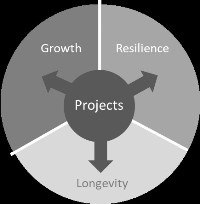A guide for board members
FEATURED PAPER
By Robert Chapman, PhD
United Kingdom
Introduction
In a world where projects are at the heart of developing business resilience, growth and longevity, their success is critical to business performance, (Figure 1). They have the potential to deliver significant business value or threaten the very existence of a company. Despite a growing body of knowledge, the development of project management methodologies and the many advances in project management techniques, poor project performance has not changed noticeably over the past 15 years (EY, 2015). Projects are defined here as temporary organizations that are created for the purpose of delivering a business product or organizational goal in accordance with an agreed business case. Projects are typically undertaken internally to support operational improvements and growth initiatives or on behalf of third parties through contract arrangements. Projects are characterized by a specific start and finish date, budget, objectives, benefits, specification or brief, outputs or deliverables. Unsuccessful projects whether implemented internally or undertaken on behalf of a client can threaten the very existence of a business. They can not only erode profits but may expose the business to litigation, fines by a regulator, demotivate staff, generate disquiet among shareholders, tarnish the business’s reputation, make the raising of future finance and winning new work more difficult, disrupt the supply chain and engage project staff longer than planned.

Figure 1: Project success is critical to business performance
To realize their company goals through projects, Boards need to ensure their businesses are both cognizant of and responsive to the volatile market place where risk exposure is growing in complexity. This is accomplished by embedding project risk management capabilities throughout the organization to develop a risk management culture. Project risk management needs to be integrated into day-to-day activities and not undertaken as a siloed parallel activity. There are not many aspects of a board’s operation that are as crucial to long-term business success as risk management (Walker, 2012). However, the most serious challenges in embedding risk management can stem from company Boards themselves. Boards must be aware of the changing landscape of risk exposure, define their risk appetite and ensure risk management is at the heart of decision making, avoiding ‘group think’. It requires project sanction to be dictated by a satisfactory business case which has addressed optimism bias, assumption analysis and risk exposure. Additionally, Board oversight must ensure that there is sufficient regular scrutiny of risk management practices to assess their maturity and effectiveness. In particular, it entails ensuring risk exposure is managed throughout each project’s life cycle (commonly with the aid of Gate Reviews). Figure 2 below describes the sequence of essential activities that Boards should engage in to drive project risk management with the goal of improving project performance.
More…
To read entire paper, click here
How to cite this paper: Chapman, R. (2019). Business performance is driven by successful projects, a guide for board members; PM World Journal, Vol. VIII, Issue IV (May). Available online at https://pmworldlibrary.net/wp-content/uploads/2019/05/pmwj81-May2019-Chapman-Business-Performance-Guide-for-Board-Members.pdf
About the Author

Robert J. Chapman, PhD
United Kingdom
![]()
Robert J Chapman is an international risk management specialist and Director of Dr Chapman and Associates Limited. He has over 20 years consultancy experience derived from providing risk management services in the UK, the Republic of Ireland, Holland, UAE, South Africa, Malaysia and Qatar on multi-billion programmes and projects. In addition, he has provided project and risk management training in Scotland, England, Singapore and Malaysia. Robert has worked in the rail, pharmaceutical, energy, road, aviation, water, property, media, heritage, leisure and marine sectors. He is the author of the texts: ‘Simple tools and techniques for enterprise risk management’ 2nd edition, published by John Wiley and Sons Limited, ‘The Rules of Project Risk Management, implementation guidelines for major projects’ published by Gower Publishing and ‘Retaining design team members, a risk management approach’ published by RIBA Enterprises. He holds a MSc in Construction Management and a PhD in Risk Management from the University of Reading and is a fellow of the IRM, APM and ICM and a lapsed member of the RIBA. Robert has passed the M_o_R, APM and PMI risk examinations. Robert is an external PhD examiner.
Dr. Chapman can be reached by email at riskappetite@outlook.com









